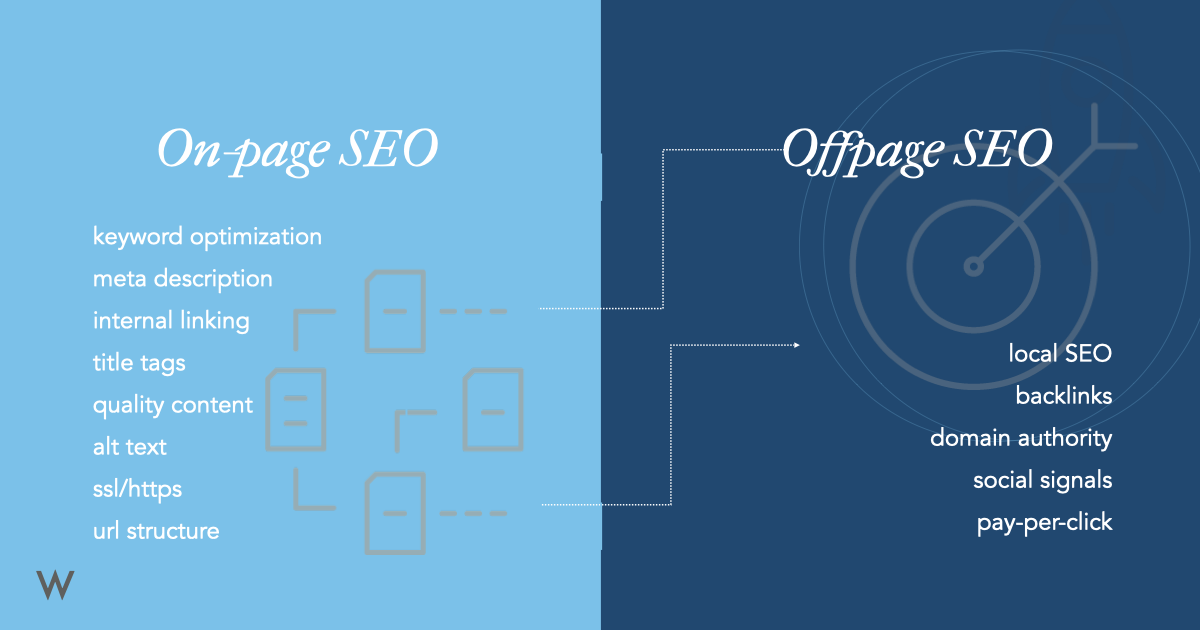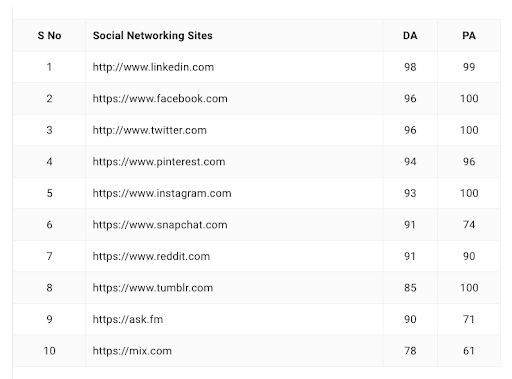On-Page SEO vs Off-Page SEO: What You Need to Know
Written by

As Google continues to continually update and modify their search engine algorithm, one constant remains: your SEO strategy needs to address both on-page SEO and off-page SEO.
Learning the ins and outs of both SEO approaches is essential for aligning your marketing plan with current best practices. This comprehensive overview of on-page vs. off-page SEO is the perfect place to start. Click a section below to jump there or better yet, read the whole article:
- What is On-Page SEO?
- On-Page SEO Factors:
- What is Off-Page SEO?
- Off-Page SEO Factors
What is On-Page SEO?
Think of the most basic search engine optimization tactics:
- Using keywords in your page title and webpage copy
- Optimizing the meta description to stand out on search engine results pages (SERPs)
- Using HTML code and alt tags
THAT’S the foundation for on-page SEO. Think of it as all the measures you take directly within your website content to:
- Make it easy for search engine bots to interpret individual web pages
- Increase website visibility and search ranking position
- Give end users accurate and enticing SERP click-through previews
- Maximize content quality, structure, and overall page performance
What, exactly, contributes to successful on-page SEO? Let’s take a closer look at the key factors.
ON-PAGE SEO FACTORS
Content
No doubt about it, content is king. You can do all of the on-page optimization around keywords, descriptions, and internal linking you want, but guess what? If the content isn’t well-reasoned, well-written, and inherently valuable to visitors, your bounce rate will be astronomical. Your average time on page numbers and conversion percentages? Not so much.
Keywords
Keyword optimization is a cornerstone of SEO. As Google better understands nuanced language and search intent get more detailed, the focus has shifted towards more long-tail keywords that encompass detailed, specific keyword phrases. Think of your audience and the keywords they’re searching for; then create and optimize your website content around those keywords.
Title Tag
A title tag is simply HTML code that enables you to name — or title — a web page. These titles appear in the browser bar and SERPs, making title tags one of the most important on-page SEO factors after your actual page content. Choose your words wisely! Titles are limited to 60 characters or less to ensure proper SERP display.
Meta Description
A meta description is a brief summary (155-160 character maximum) of web page content. Meta descriptions show up as part of a SERP snippet and typically below a headline in a social post to help users understand how your content is relevant to their search query, and to encourage clicks.

Alt Text
Alt text (also referred to as alt tag or alt description) is a brief written description of an image that appears on a web page. In the event the image doesn’t load properly, alt text populates the space so users know what they’re missing. Screen-reading tools also use alt text to describe images to visually impaired users. For on-page SEO purposes, alt text allows search engines to better crawl and rank websites.
For example, if you use a graphic in your blog that outlines some injection molding tips, you can save the alt text for that image as “automotive-injection-molding-tips.” The graphic will then start to rank for that phrase in the image results.
Secure Sockets Layer (SSL)/HTTPS
Page security is more important than ever, and enabling Secure Sockets Layer (SSL) security technology is crucial for improving your security, trustworthiness, and visibility. Why? SSL protects the information exchanged between your web server and a visitor’s web server from being poached by a third party — particularly important when the information shared is sensitive, such as credit card numbers or personally identifiable details.
An SSL certificate is purchased by a website owner to digitally authenticate the site’s identity and to enable encrypted connectivity. (Note, for HubSpot users, SSL is included in your CMS license, not an additional purchase.) On SSL-protected websites, a padlock icon and/or the word “Secure” appears in the Google browser bar and “https” precedes the page address:

Seeing “Not Secure” in place of the padlock icon or receiving a “Your connection is not secure” error message tips users off to sites without SSL certificates — and potential trouble.
Google has gone from preferring that sites have SSL certificates to basically requiring it — not to get tough on you, but rather on cybercrime. Google will automatically flag any site lacking an SSL certificate as “Not Secure” and, conversely, reward sites using SSL by prioritizing them in SERPs.
URL Structure
An organized URL structure allows search engines to easily crawl from page to page on your website and makes navigation more efficient for visitors. URLs containing keywords that reflect the pages they direct to are easy to understand are more likely to earn clicks — but don’t get chatty. URLs should be relatively short, use your primary keyword for that page and omit redundant words.
Internal Linking
Speaking of linking, internally linking related pages on your website is another important factor of on-page SEO. It’s a simple way to assist search engine crawls of your site and keeps visitors engaged longer.
This is where pillar pages come into play. Dedicating website pages to popular topics simplifies searches for users and allows you to link all related pages back to that pillar. Let’s say you want to create pillar pages dedicated to automotive, medical, and consumer injection molding applications. With your pillars identified, you can tailor your content and URL strategy specifically to those pillars, link all related content back to the main pillar page, and help you boost your searchability on those topics.
Breadcrumb Navigation
Breadcrumbs are navigational aids that inform website visitors where they are on your site, and also help Google understand and convey the structure of your website in search results. As seen in the HubSpot page screen grab below, breadcrumb navigation appears as a small text path typically located at the top of a page, with every step being clickable:

Structurally, there are three different types of breadcrumbs:
- Hierarchy-based shows the number of steps it takes toreturn to the Home Page
Home > Blog > Industry > Title of Post - History-based is ordered by visitor activity on the site
Home > Previous Page Name > Previous Page Name > Current Page - Attribute-Based lists product features, and is most common on e-commerce sites
Home > Product Area > Style > Material > Size
Page Performance
While other factors of on-page SEO deal with content quality and structure, the performance of your website (and its pages) is also a on-page ranking factor for consideration. Pages that take a long time to load or don’t render properly on mobile rank lower in SERPs as users get frustrated, leave, and increase the bounce rate.
RELATED: How to Optimize Website Page Load Speed for Improved SEO Results
Search engines evaluate page performance and value it as a key page ranking factor. As such, it’s crucial to manage your website accordingly — pay attention to image file sizes, reduce redirects, improve mobile responsiveness, and minimize the amount of CSS/Javascript.
Mobile Responsiveness
With 6.64 billion smartphone users in the world and 1.28 billion people with tablets1,2, the search for information seems constant. Needless to say, a mobile-friendly website is a critical part of your online presence.
There are two big reasons to make sure visitors with mobile devices have a good experience on your site:
- Sites not optimized for mobile force visitors to pinch or zoom just to read content, which is frustrating and could cause them to bounce
- Google predominantly uses mobile-first indexing, which means it favors mobile content over the desktop version for indexing and ranking page relevance to user queries.
Schema Markup
Schema markup is structured data in the semantic vocabulary of search engines to improve their understanding of content specifics. It is used by Google to get information for accurate, information-rich SERP featured snippets. Schema markup is used in a variety of popular content marketing scenarios, including:
- Business events
- Search results
- FAQ pages
- News articles
- Job postings
- Local business information
Core Web Vitals
Launched in spring of 2020, Google’s Core Web Vitals helps determine a website’s page performance as well as user experience to identify opportunities to improve.
Each of the Core Web Vitals represents a unique part of the user experience, and reflects the real-world experience of a visitor. The set covers three aspects of the user experience on a website: loading, interactivity, and visual stability.
RELATED: CORE WEB VITALS CASE STUDY: HOW TO IMPROVE YOUR SCORES & BOOST SEO
Page Experience
Page experience is a set of signals comprised of Core Web Vitals, mobile-friendliness, seite security (https), and interstitial intrusiveness. Core Web Vitals measure users’ perceptions of and actual experience with web page interactions (both mobile and desktop) beyond the value of the information, while the balance of the signals focus on search metrics.
Interested in optimizing your on-page SEO? Check out SE Ranking and their on-page SEO checker.
What is Off-Page SEO?
On-page SEO is directly in your control — you can tinker with keywords, title tags, meta descriptions and other factors we just discussed to build user-friendly content that ultimately increases website visibility in search enginers.
Off-page SEO, on the other hand is not fully in your control. Off-page SEO works to boost website popularity in general and, by extension, improve the SERP positioning that on-page SEO visibility initially made possible. This all happens as a result of certain ranking factors that leverage opportunities that are separate from — but funnel back to — your website. You have less influence over performance as compared to on-page SEO, but that doesn’t make off-page SEO less valuable.
OFF-PAGE SEO FACTORS
Backlinks and Link Equity
The number and quality of backlinks you have to your site is undoubtedly the biggest factor of off-page SEO. The more legitimate sites linking to your content, the more domain authority Google grants your site, boosting your rankings.
The quest for backlinks that help a website rank higher has led many a marketer into the snares of questionable paid link-building tactics that aren’t even necessary. There are several organic approaches to link building you can take that produce effective off-page SEO results, such as:
- Guest blogging
- Being featured in industry trade publications
- Reaching out to industry contacts to request content shares
- Participating in a podcast
- Participating in an industry community, such as a forum
- Hosting events (in-person or virtual)
- Being an expert resource for Help A Reporter Out [HARO]
- Issuing press releases that are distributed on industry sites
Leveraging these opportunities can help you tap into the link equity of trusted sites.
Link equity is a search engine ranking factor that uses page authority, topical relevance, and other metrics to determine how much value and authority a link passes from one page to another. Links deemed to have equity carry weight in determining page rankings in SERPs.
Oh, and one more bit of advice about off-page SEO linking. The backlink anchor text — which is the text other websites use to link to your website — deserves careful consideration. Including company names and/or applicable brand mentions in anchor text instead of keywords boosts name recognition, but doesn’t do much for off-page SEO rankings. Instead, the anchor text should be related to the content that is linked and indicative of a relevant keyword you’re targeting.
Domain Authority
Measured on a scale from 1-100, your domain authority is a number search engines assign to the strength of your website. It ultimately predicts the likelihood of a site ranking in search results. The formula is simple — the higher the domain authority, the higher the chances of a favorable SERP ranking.
Domain authority is measured by a few different factors, including how long you’ve had your domain name (the longer the better), the history of the domain name, the number of backlinks, and the number of 404 error messages (which indicate missing pages). By ensuring you have a technically sound website that follows the SEO best practices, you can maximize your domain authority and improve your ranking.
Shareable Content
It bears repeating: Content is king. Creating helpful content that is worthy of sharing is one of the best ways to maximize SEO. It’s also an ideal way to generate backlinks to your website and blog, and get social media buzzing.
Social Media Engagement
Connecting with people on multiple social media platforms can easily amplify blog and website popularity. A strong social media presence also builds business and backlink opportunities. Here’s a peek at the Top 10 Social Media Sites for Link Building along with their Domain Authority (DA) and Page Authority (PA) metrics:

Local SEO
Online profiles on sites like Google My Business and Yelp help boost local SEO because they revolve around your location. With local citations, you’ll likely turn up in the searches of users near you who are looking for the types of products and services you offer.
Pay-per-Click Campaigns (PPC)
I am sure you’re thinking, “This is supposed to be about SEO!” Well, SEO is part of a good pay-per-click (PPC) campaign and vice versa. When your site (or a new page on your site) is still getting off the ground, you need to get visitors, and leveraging PPC on Google, Twitter, Facebook, and LinkedIn can help with that. But remember — PPC campaign performance is only as good as the content offer and the targeting parameters, which both should be steeped in keyword research. With solid content, PPC generates more traffic to your site, backlink opportunities, and more robust off-page SEO.
On-page and off-page SEO work together to improve search engine rankings. By working on what you can control today — producing quality content that’s supported by high-quality on-page SEO — you’ll be well on your way to earning backlinks, improving your domain authority, and controlling your off-page SEO.
Ready to learn more about SEO? Check out our on-demand webinar, Demystifying SEO: Be Found in Online Searches By Your Ideal Prospects.
SOURCES:
1 Earthweb, 40 Smartphone Statistics 2022: How Many People Have Smartphones? - EarthWeb, August 1, 2022
2 TechJury, 21 Tablet Statistics and Facts You Need to Know in 2022, June 17, 2022
Subscribe To Our Blog
Information. Insights. Ideas. Get notified every time a new Weidert Group blog article is published – subscribe now!
You May Also Like...

Artificial Intelligence
Revenue-Driving B2B Content Marketing Strategy with Andy Crestodina

Artificial Intelligence
AI Agents Are Here—How Smart Businesses Are Using Them Now

Inbound Marketing
Podcasting Playbook: What We Learned After 100 Days of Running a B2B Podcast
Accelerate Your Growth with
Weidert Group
If you’re ready to explore a partnership, request a personalized consultation with our team.

